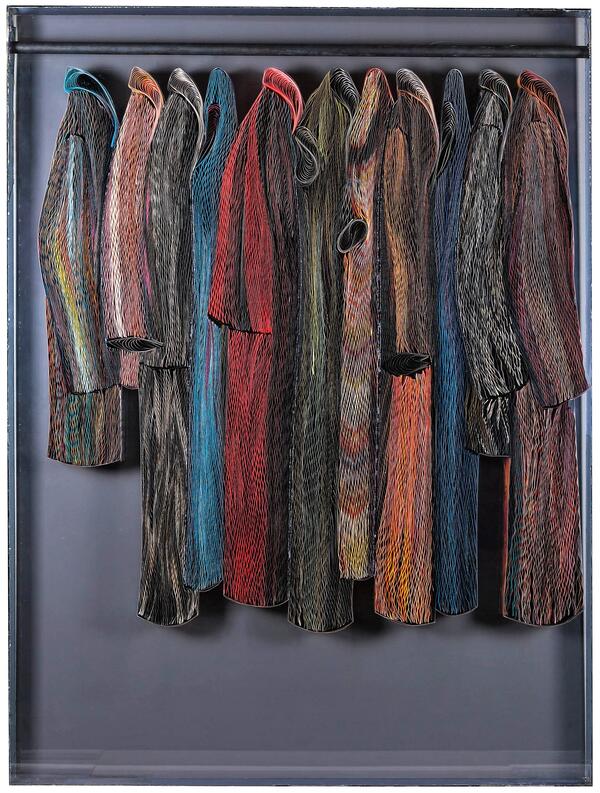The painting “Cloakroom IV” was created by the Greek painter Pavlos Dionysopoulos in 1968. The artist depicted a few life-size coats, fur coats and jackets of different colors. The work consists of strips of paper, cut out from magazines and posters and arranged in different positions to demonstrate the textures and colors of various materials, including fur.
The work creates an illusion of an oil painting that depicts clothes hanging in a closet. Upon a closer look, the closet turns into numerous strips of paper glued next to each other. The special technique used by Pavlos Dionysopoulos is called defamiliarization, which makes the viewer see “Cloakroom IV” from a new perspective instead of processing it in a familiar and automatized way.
Pavlos Dionysopoulos was born in the Greek town of Filiatra in 1930. He studied art at the Athens School of Fine Arts. After graduating, Dionysopoulos got a scholarship and settled in Paris as an intern in 1954. In 1955, he returned to Athens and worked in advertising and theatres for the next three years. Later he was granted a three-year scholarship by the Greek government and moved to Paris for good.
In the 1960s, Dionysopoulos began using posters and magazines as media for his works. He cut them into 10-centimeter -wide stripes and goffered them by forming folds with a corrugating machine. The processed sheets were closely arranged in rows. Dionysopoulos’s works made of such strips look textured, embossed and almost three-dimensional.
For this composition, Dionysopoulos chose to combine such a simple thing as a closet with strips cut out from magazines representing popular culture. Researchers claim that this vision could have been influenced by the philosophy of Pop Art.
Pop Art is an artistic trend that emerged in the late 1950s — 1960s in the United States and Western Europe. It depicted products of mass culture and the material world such as magazines, comics, television and cinema.
Dionysopoulos’s works were exhibited in many European countries, including Greece, France, and Germany. In 1980, he represented Greece at the Venice Biennale.
The work creates an illusion of an oil painting that depicts clothes hanging in a closet. Upon a closer look, the closet turns into numerous strips of paper glued next to each other. The special technique used by Pavlos Dionysopoulos is called defamiliarization, which makes the viewer see “Cloakroom IV” from a new perspective instead of processing it in a familiar and automatized way.
Pavlos Dionysopoulos was born in the Greek town of Filiatra in 1930. He studied art at the Athens School of Fine Arts. After graduating, Dionysopoulos got a scholarship and settled in Paris as an intern in 1954. In 1955, he returned to Athens and worked in advertising and theatres for the next three years. Later he was granted a three-year scholarship by the Greek government and moved to Paris for good.
In the 1960s, Dionysopoulos began using posters and magazines as media for his works. He cut them into 10-centimeter -wide stripes and goffered them by forming folds with a corrugating machine. The processed sheets were closely arranged in rows. Dionysopoulos’s works made of such strips look textured, embossed and almost three-dimensional.
For this composition, Dionysopoulos chose to combine such a simple thing as a closet with strips cut out from magazines representing popular culture. Researchers claim that this vision could have been influenced by the philosophy of Pop Art.
Pop Art is an artistic trend that emerged in the late 1950s — 1960s in the United States and Western Europe. It depicted products of mass culture and the material world such as magazines, comics, television and cinema.
Dionysopoulos’s works were exhibited in many European countries, including Greece, France, and Germany. In 1980, he represented Greece at the Venice Biennale.


